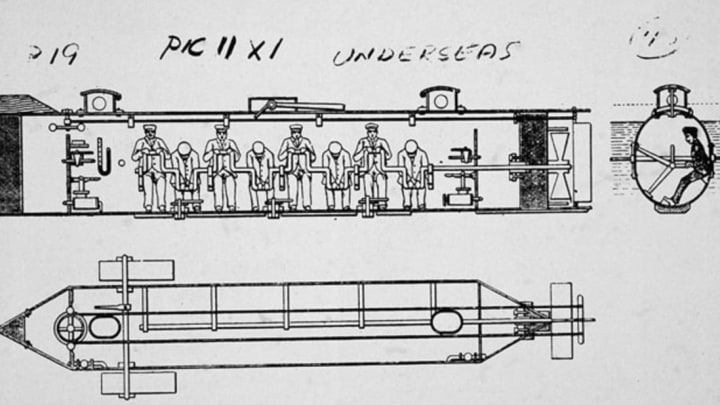When I hear the word “submarine,” I think of something out of The Hunt For Red October. Yet sub-surface warfare predates the Cold War by over a century. In fact, the first conflict to put military submarines in action was the Revolutionary War, and it was the American Civil War which saw the world’s first spurt of successful submarine combat.
Underwater Revolution
In 1775, Connecticut resident and Yale University science student David Bushnell constructed a one-man craft which was described as resembling “two upper shells of a tortoise joined together." Appropriately, it was dubbed the Turtle. An amazed George Washington called the project “an effort of genius.”
The Turtle was eventually lost when a vessel carrying it sank in the Hudson River, and when the War of 1812 cropped up, a new one-man submarine was crafted for the American cause by another Connecticut inventor named Silas Halsey. Halsey went down with his ship on the night of June 30, 1813. It wouldn’t be the last time a primitive submarine claimed the life of its builder.
Uncivil Ships
Submarine building continued during the Civil War. The Confederates’ first underwater attack vessel—the CSS Pioneer—was built in New Orleans in 1862, but was later dismantled prior to the Union’s conquest of the city. Though it was never used, the new ship had dwarfed its forebears at 30 feet in length and could hold a whopping two crewmembers. The Pioneer II (also known as the American Diver) had a more hydrodynamic design and featured an expanded interior built for four to five men. But the American Diver met a watery grave in Alabama’s Mobile Bay during a test-run in 1863 (though her crew was rescued).
Meanwhile, the North was busily working on its own submarine. A Union sub called the USS Alligator was built and tested in 1861. Its greatest innovation was a sealable hatchway that would allow divers to exit the vessel underwater. In 1863, the unmanned 45-foot ship was lost at sea while being towed to Charleston, and has never been recovered despite decades of searching.
Later that year, a vastly-improved ship named the H.L. Hunley was built. At nearly 40 feet in length and 7.5 tons in weight, the vessel was intended for a crew of eight: one man would steer while his companions would sit along a wooden bench and manually rotate a crankshaft that turned the propeller.
The H.L. Hunley sank twice during its training period, killing most or all of its crew on each occasion, including her designer and namesake Horace Hunley on the second attempt. But she was recovered each time, and finally embarked on her first mission on the night of February 17, 1864.
The task was to destroy a Union vessel in the blockade of Charleston’s outer harbor. To accomplish this, a 17-foot-long spar had been fitted to the Hunley’s bow, with a barbed container of explosives secured to its tip. The stealthy vessel deposited its torpedo upon the USS Housatonic, which sank after the resulting explosion—the first ship in world history to be capsized by a submarine attack. For unknown reasons, the Hunley herself also sank shortly thereafter.
The Hunley was eventually rediscovered in 1970. Thirty years later, after extensive archaeological analysis, she was finally brought back to the surface, and is undergoing further study in the Warren Lasch Conservation Center. Plans for a permanent museum are currently being laid out.
